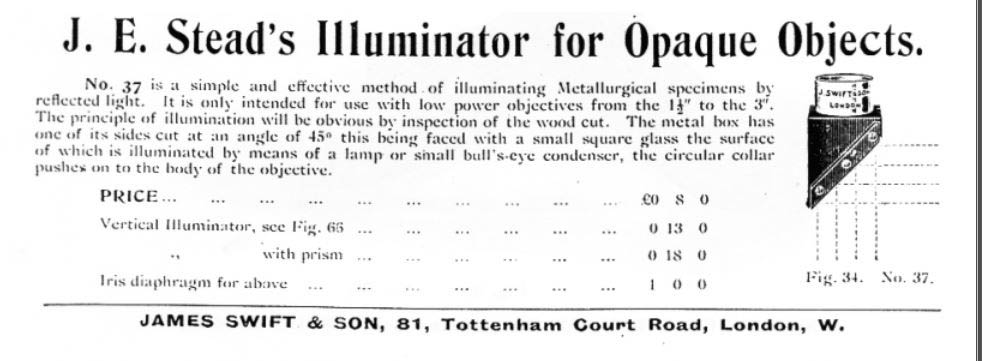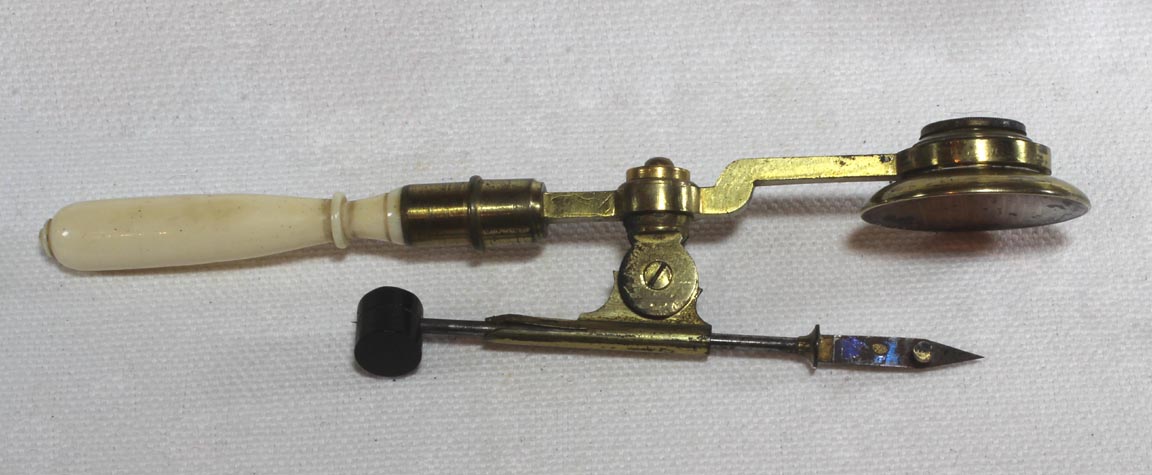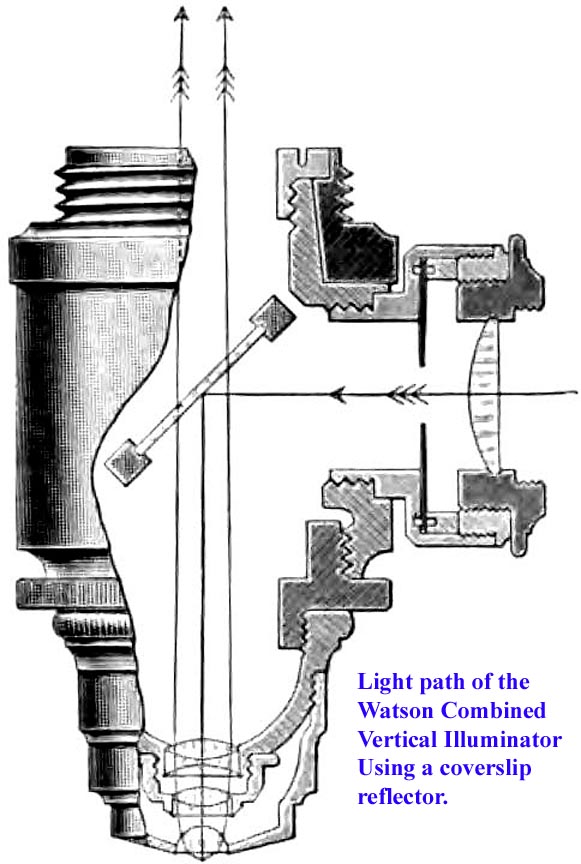COMPOUND TRIPOD MICROSCOPE FOR INSPECTION OF METAL SURFACES
MAKER: J. SWIFT & SON
c. 1915
MODEL: 'STEAD WORKSHOP MICROSCOPE'
SIGNED: 'J. SWIFT & SON, LONDON; J.E.STEAD F.R.S., WORKSHOP MICROSCOPE, W.E.Co Ltd, LONDON'
Please Click On Any Picture for a Larger Version
DESCRIPTION:
This microscope arises from a tripod. Three supporting legs are screwed into a disk surrounding the sleeve which holds the compound body of the instrument. Focusing is by push or pull and focus can be locked in any position with the knurled knob. The three tripod legs each have individual height adjustment so that the microscope can function on either a flat or round or even irregular surface. Tbe instrument has a unique objective which has a slot to accept a coverslip as a reflector. A 1/4" hole on the side of the slot allows the light beam to enter and be reflected downward onto the subject being studied; a thin silver reflector could also be used because the slot only goes in about 1/3 the diameter of the objective, thus allowing the image of the object to reflect back up around the reflector to the eyepiece. There is a tiny hole on the opposite side so that the operator can tell the light is indeed on. The low-voltage lightbulb is integrated into a nickel plated sleeve which fits over the objective, slid up from the bottom. This fitting incorporates an angled opening so that it can slide up against. or close to, the coverslip acting as a reflector. The microscope is made of lacquered brass with the exception of the tightening ring which is blackened brass and the objective which is nickel plated. There is no signature on the eyepiece nor the objective although the eyepiece is removable. There is no draw tube. The disc supporting the legs is signed at the 12 o'clock position 'J. Swift & Son' and underneath this, 'London'. It is signed at the 9 o'clock position 'W.E.Co Ltd and at the 3 o'clock position 'London'. At the 6 o'clock position it is signed 'J.E. Stead F.R.S.' and under this, 'WORKSHOP', and under that, 'MICROSCOPE'. The instrument came with a mahogany box designed to hold a dry battery with an integrated on-off switch. The fixture holding the bulb slides out the nickel plated sleeve for replacement if needed. The battery box measures approximately 3 1/8" x 1 7/8" x 2 3/4" high. Today it can hold two 'C' batteries. The inside dimension designed to take the battery measures approximately 2.5 x 1 1/16" x 2 1/2" deep. The purpose made case for the instrument, also of mahogany, has the contact areas of the fittings covered in green felt.
HISTORY OF THE STEAD WORKSHOP MICROSCOPE:
The term 'workshop' in this case refers to the metallurgical workshop, where large pieces of metal were to be inspected with a portable microscope like this one. This particular design, by Stead as the signature notes, was made by Swift. The design of the illuminator used for this microscope was reported in the Journal of the Royal microscopical Society in 1909. The engraving above is from the book: The Metallography of Iron and Steel by Albert Sauveur, second edition, 1916. Stead also also reported in the same 1909 RMS article the design of a vertical illuminator for low power which slides on over the outside of the objective:

OTHER PORTABLE METALLURGICAL MICROSCOPES AND VERTICAL ILLUMINATORS
HISTORY OF EPISCOPIC ILLUMINATION
The very first microscopes used only top lighting. These included tripod microscopes with a flat opaque stage. Soon however, this was insufficiently bright. At first this problem was addressed by using a device to concentrate light on the specimen; these often used a lens or lens system to concentrate the light from the side above the specimen. The large single 'bullseye' condenser was used for this purpose for centuries. It could be freestanding as in a 'bench' condenser, or come off an adjustable arm pivoting off the stage, arm or even main optical tube of the microscope. When electric lights became a common illumination source, the bullseye lens was eventually built in to them.
 Another method of illuminating an opaque object was the Lieberkuhn. This idea dates back to Descartes in 1637 and also to Van Leeuwenhoek. But other than by Van Leeuwenhoek, the idea was not pursued much, until Johannes Lieberkuhn popularized the idea in Europe and then England in about 1738. It was John Cuff who was apparently the first in England to latch on to this idea and by the early 1740's was producing an improved compass microscope he called his 'Microscope for Opake Objects'. A slightly later example of the Lieberkuhn compass microscope (c 1800) is shown here to the left. This speculum device surrounds the objective. Light is directed from behind the object, (or below the stage in microscopes with a stage), passes around the opaque object, and is then reflected back onto the object by the Leiberkuhn. Cuff incorporated Leiberkuhns into his 'Ellis Aquatic' simple microscopes and on the nosepiece of his 'Cuff-type' compound microscopes. Leiberkuhn reflectors designed for individual objectives were supplied by most manufacturers well into the 1880's.
Another method of illuminating an opaque object was the Lieberkuhn. This idea dates back to Descartes in 1637 and also to Van Leeuwenhoek. But other than by Van Leeuwenhoek, the idea was not pursued much, until Johannes Lieberkuhn popularized the idea in Europe and then England in about 1738. It was John Cuff who was apparently the first in England to latch on to this idea and by the early 1740's was producing an improved compass microscope he called his 'Microscope for Opake Objects'. A slightly later example of the Lieberkuhn compass microscope (c 1800) is shown here to the left. This speculum device surrounds the objective. Light is directed from behind the object, (or below the stage in microscopes with a stage), passes around the opaque object, and is then reflected back onto the object by the Leiberkuhn. Cuff incorporated Leiberkuhns into his 'Ellis Aquatic' simple microscopes and on the nosepiece of his 'Cuff-type' compound microscopes. Leiberkuhn reflectors designed for individual objectives were supplied by most manufacturers well into the 1880's.
As time went on, and as the optics improved, and shorter focal length objectives of higher power became common, lighting from the side became inadequate and Lieberkuhn reflectors were impractical for larger objects or surfaces. In order to use a Lieberkuhn the subject has to be small enough for the light to pass around it and still reflect off the speculum. Vertical illuminators could work with any size object.
Vertical illuminators are used for illumination of solid or opaque objects with higher power objectives.
Although with low power, top-illumination from the side can suffice, as the magnification increases and the focal length shortens, light cannot easily be directed onto the top of an opaque specimen.
 The vertical illuminators allow the light to come directly down onto the specimen from above through the objective, by reflecting incoming light off a coverslip or prism at an angle (usually 45o) which at the same time allows the reflected light to pass vertically back up through the coverslip or around the prism upwards towards the the eyepiece.
The vertical illuminators allow the light to come directly down onto the specimen from above through the objective, by reflecting incoming light off a coverslip or prism at an angle (usually 45o) which at the same time allows the reflected light to pass vertically back up through the coverslip or around the prism upwards towards the the eyepiece.
Early versions were simply a tube with a hole and an angled coverslip inside. As time went more features were added such as the capacity to regulate the light entering and eventually built-in condensing lenses as shown here to the left. With the coverslip type, the light enters from the side, is reflected down on the object being studies, and goes up vertically through the coverslip. A tiny prism could also be used, but in this case it is so small, light is able to pass up the illuminator around it, rather than through its center. These arrangements both have disadvantages but the Watson-Conrady type, a predecesor of the modern type of vertical illuminator, provides much better illumination of opaque objects. Another variation of vertical illumination is to direct light vertically down upon the object via a reflector around the outside of the objective, or in an earlier version, around the optical tube. In the modern form, in a process known as 'epi-illuminiation' the light to the reflector is supplied by a sophisticated light path from above the reflector, obviating the problems with Lieberkuhn reflectors and allowing any size object to be examined. An earlier type, using a reflector around the optical tube, can be seen on the Degen Microscope in this collection.
An example of the epi type of illumination can be seen in the Wild Epi-illuminator in this collection which uses specialized objectives, each with an optimized light path and reflector which surrounds the objective. An example of a modern microscope in this collection using a vertical illuminator similar to the Watson-Conrady device is an Olympus Vanox microscope with vertical illumination. That instrument has capabilities for not only brightfield vertical illumination, but also polarized light illumination and even interference contrast. Modern vertical illuminators are similar to the Watson-Conrady model except instead of a coverslip as reflector, they use a beam-splitting prism, which allows highly reflected light to illuminate the object while at the same time allowing most of the light bouncing off the object to pass back vertically through the beam splitter towards the eyepiece.
Stead's was not the only metallurgical microscope designed for surface inspection. In about the same year Stead's instrument came out, Watson came out with their 'Vulcan' Model.
For more on the history of vertical or episcopic illumination and examples of several different variations of vertical illuminators please see the Vertical illuminator page.

 Another method of illuminating an opaque object was the Lieberkuhn. This idea dates back to Descartes in 1637 and also to Van Leeuwenhoek. But other than by Van Leeuwenhoek, the idea was not pursued much, until Johannes Lieberkuhn popularized the idea in Europe and then England in about 1738. It was John Cuff who was apparently the first in England to latch on to this idea and by the early 1740's was producing an improved compass microscope he called his 'Microscope for Opake Objects'. A slightly later example of the Lieberkuhn compass microscope (c 1800) is shown here to the left. This speculum device surrounds the objective. Light is directed from behind the object, (or below the stage in microscopes with a stage), passes around the opaque object, and is then reflected back onto the object by the Leiberkuhn. Cuff incorporated Leiberkuhns into his 'Ellis Aquatic' simple microscopes and on the nosepiece of his 'Cuff-type' compound microscopes. Leiberkuhn reflectors designed for individual objectives were supplied by most manufacturers well into the 1880's.
Another method of illuminating an opaque object was the Lieberkuhn. This idea dates back to Descartes in 1637 and also to Van Leeuwenhoek. But other than by Van Leeuwenhoek, the idea was not pursued much, until Johannes Lieberkuhn popularized the idea in Europe and then England in about 1738. It was John Cuff who was apparently the first in England to latch on to this idea and by the early 1740's was producing an improved compass microscope he called his 'Microscope for Opake Objects'. A slightly later example of the Lieberkuhn compass microscope (c 1800) is shown here to the left. This speculum device surrounds the objective. Light is directed from behind the object, (or below the stage in microscopes with a stage), passes around the opaque object, and is then reflected back onto the object by the Leiberkuhn. Cuff incorporated Leiberkuhns into his 'Ellis Aquatic' simple microscopes and on the nosepiece of his 'Cuff-type' compound microscopes. Leiberkuhn reflectors designed for individual objectives were supplied by most manufacturers well into the 1880's.  The vertical illuminators allow the light to come directly down onto the specimen from above through the objective, by reflecting incoming light off a coverslip or prism at an angle (usually 45o) which at the same time allows the reflected light to pass vertically back up through the coverslip or around the prism upwards towards the the eyepiece.
The vertical illuminators allow the light to come directly down onto the specimen from above through the objective, by reflecting incoming light off a coverslip or prism at an angle (usually 45o) which at the same time allows the reflected light to pass vertically back up through the coverslip or around the prism upwards towards the the eyepiece.